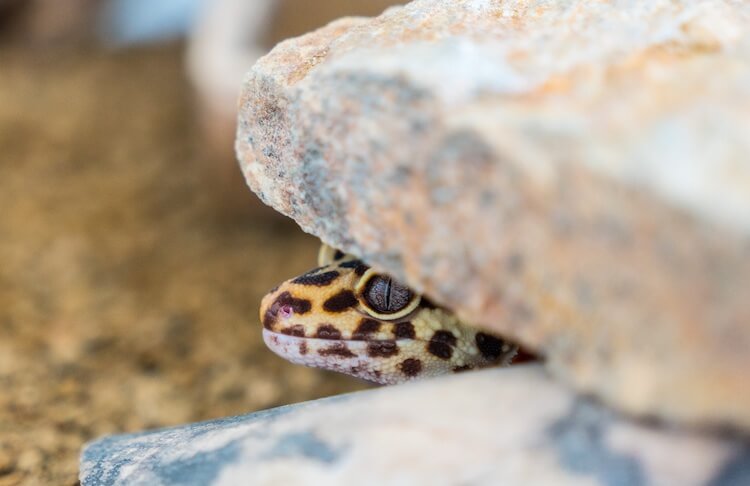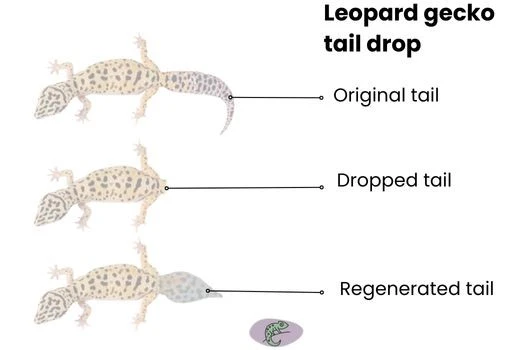Leopard geckos are fascinating creatures that make great pets for reptile enthusiasts. They are known for their unique appearance, friendly personalities and impressive survival skills. One of these survival skills is their ability to drop their tails, a trait that has evolved over time to help them escape from predators. In this article, we’ll look at why leopard geckos drop their tails, what happens when they do, and how you can prevent your gecko from losing its tail.
Why do leopard geckos drop their tails?
The most common reason leopard geckos drop their tails is as a natural defence mechanism. When threatened, they can detach their tail from their body and distract predators with the wriggling tail while they make their escape. This survival tactic is known as caudal autotomy and it’s common in many reptile species.
Stress-related Leopard gecko tail drop
Another reason why leopard geckos may drop their tails is stress. Stress can be caused by a variety of factors such as handling, poor living conditions or disease. When stressed, leopard geckos may drop their tails as a sign of distress. This can be a serious problem as a stressed leopard gecko is more susceptible to illness and disease.
Related content: Full Leopard Gecko Care Guide
Signs of stress in leopard geckos
Leopard geckos, like all animals, can experience stress in a variety of ways. Here are some signs to look out for:
- Loss of appetite: Leopard geckos that are stressed may stop eating or show a decrease in appetite.
- Hiding: Leopard geckos that are stressed may hide more often than usual. They may also retreat to their hiding places more often and for longer periods of time.
- Aggression: Stressed leopard geckos may become more aggressive than usual. They may bite or hiss at their owners or even other geckos in their enclosure.
- Lethargy: Stressed leopard geckos may become lethargic and inactive. They may not move as much as usual or appear sluggish.
- Tail wagging: Leopard geckos may wave their tails if they are stressed or feel threatened.
- Abnormal shedding: Leopard geckos that are stressed may have abnormal shedding, such as stuck or incomplete shedding.
- Colour changes: Stressed leopard geckos may exhibit colour changes, such as becoming paler or darker than usual.
How to prevent stress-related tail loss
Preventing tail loss in leopard geckos involves proper handling techniques, a suitable environment and a healthy diet.
Let’s start with proper handling techniques. When handling leopard geckos, it’s important to avoid grabbing them by the tail. Instead, support their body and let them crawl onto your hand. Also avoid sudden movements and loud noises as these can cause stress and increase the risk of tail loss. If your gecko is unaccustomed to being handled, start with short sessions and gradually increase the time to help him get used to it.
Providing a suitable environment is also essential. Leopard geckos need a warm and humid environment to thrive. Provide a basking area with a temperature of 28-31 °C and a cooler area with a temperature of 27-29 °C. Humidity should be maintained at around 30-40%. Providing adequate hiding places, such as caves or tree trunks, will also help your gecko feel secure and reduce stress.

A healthy diet is another key factor in preventing tail loss. Leopard geckos are insectivores and require a varied diet of crickets, mealworms and other insects. Feed them appropriately sized prey, as feeding too large insects can cause digestive problems. You can also offer calcium and vitamin D3 supplements to help prevent metabolic bone disease.
How leopard gecko tail dropping works
When a leopard gecko is threatened, its tail will twitch and flap, distracting the predator and giving the gecko a chance to escape. At the same time, the gecko will contract its tail muscles and break the tail at a specific point called the ‘breakpoint’. The tail will then break off, leaving the predator distracted with a wriggling tail while the gecko makes a quick getaway.
This may seem like a drastic measure, but it’s actually an effective way for leopard geckos to avoid being eaten or harmed.
It’s important to note, however, that dropping the tail comes at a cost – the gecko will lose a significant amount of energy and resources stored in the tail. Also, the regenerated tail will never be quite the same as the original. The new tail may be shorter, thicker or a different colour to the original. This is because the regenerated tail lacks some specialized structures and pigments that the original tail had.
What happens after a leopard gecko loses its tail?
Initially, a small bump called a “regeneration bud” will appear where the tail was lost, and this will gradually grow into a new tail. It’s important to note that the regenerated tail will never be exactly the same as the original and may be shorter, thicker or a different colour.

Timeline
The timing of tail regeneration in leopard geckos can vary depending on several factors, including the age and health of the gecko, as well as the conditions of its environment. On average, the regeneration process can take anywhere from four to eight weeks, but in some cases it can take longer.
Factors affecting regeneration
Numerous factors can affect the regeneration of a leopard gecko’s tail, including the age and health of the gecko, the severity of the tail loss, and the conditions of its environment. Older or unhealthy geckos may have a harder time regenerating their tails, and severe tail loss may result in a longer regeneration time or inability to regenerate at all. A clean and stress-free environment is also important for the regeneration process, as both stress and infection can inhibit regeneration.
Risk of infection
During the regeneration process, leopard geckos may be more susceptible to infection due to the open wound where the tail was lost. It’s important to monitor the wound closely and keep it clean to reduce the risk of infection.
Signs of infection include:
- redness
- swelling
- discharge foul odour
If you suspect that your gecko’s wound is infected, it’s important to see your vet immediately.
Proper care during regeneration is also critical to ensure the health and well-being of the gecko. This includes providing a clean and stress-free environment, avoiding excessive handling, and providing a healthy diet to support the regeneration process. A healthy and stress-free gecko is more likely to regenerate its tail successfully and without complications.
- Provide a clean and comfortable environment – keep your gecko’s enclosure clean, dry, and free from any sharp objects that could potentially damage the wound. Make sure to remove any loose substrate that has the potential to sick to the wound.
- Keep an eye on your gecko’s behavior during the regeneration process. If you notice any signs of stress, such as decreased appetite or lethargy, it could be a sign of infection or other health issues.
- Try to avoid handling your gecko as much as possible during the regeneration process. Handling can cause unnecessary stress and potentially damage the wound.
What we’ve learned
In conclusion, leopard geckos dropping their tails is a natural defence mechanism that has evolved over time to help them escape from predators. While it can be alarming for owners to witness their gecko losing its tail, it’s important to remember that this behaviour is completely normal and can actually save their lives. As pet owners, it’s crucial to create a stress-free environment for our geckos, as stress can trigger tail dropping.
